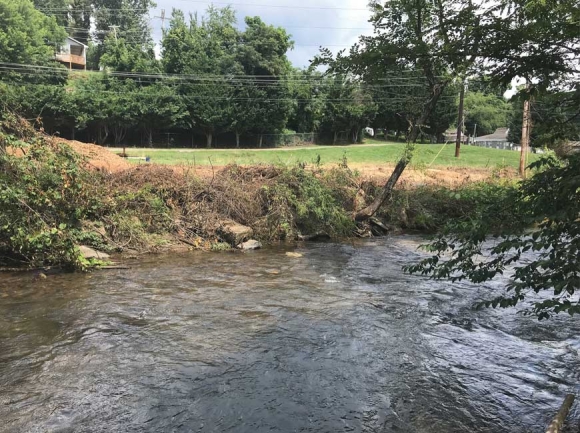Frog Level flora flap finished
 A section of Richland Creek was recently cleared of trees and brush, much to the chagrin of brewer Clark Williams. Cory Vaillancourt photo.
A section of Richland Creek was recently cleared of trees and brush, much to the chagrin of brewer Clark Williams. Cory Vaillancourt photo.
It’s been said that the road to hell is paved with good intentions, but after an overzealous brush-clearing operation behind Frog Level Brewing Company and Panacea Coffeehouse, apparently so are the banks of Richland Creek.
“I was shocked,” said Clark Williams, owner of FLBC in Waynesville’s Frog Level district. “I was like, ‘What are they doing?’”
Williams said on July 3 he was notified by one of his employees that a tree-trimming crew contracted by the Town of Waynesville was working its way up Richland Creek. Williams’ brewery shares a spacious back deck with Panacea that abuts Richland Creek; it’s a popular spot, especially in summer, and especially with local bar-hoppers.
Thus Williams was understandably upset when a stand of brush and trees that lined the opposite bank of the creek right behind his deck — screening the Giles Chemical-owned lot behind it — was cut to the ground. The trimming came at the request of Giles, and was in response to some of the trees there causing a dangerous situation with overhead power lines.
That same day, Williams took to Facebook to air his grievances, saying that the noise, dust and debris made the day intolerable for customers, that the majority of what was cut wasn’t endangering the power lines, and that the privacy of nearby homeowners would also suffer.
Although he did say that he thought the aesthetic of the area would suffer somewhat, he was less concerned about his business — “people are still going to come drink beer on the deck” — than he was about possible negative effects on the ecology.
Related Items
“I’m concerned about the temperature of the water, the ecosystem along the bank, and the aquatic life that calls that place home,” he said.
When Waynesville Alderman Jon Feichter became aware of the situation, he immediately paid a visit to Williams.
“I’d seen his [Facebook] pictures the night before, so I went down that next day and talked with him, and my first reaction when I went out onto his back deck there was that it looked worse than the pictures did,” Feichter said.
He then ventured over to the other side of the creek, where the trimming occurred, describing it as “devastation.” The trees weren’t merely trimmed, but were clear-cut due to allegations of drug activity taking place there.
“I fully understand and support the town having to trim the trees to remove any threat to the power lines, but I do think we can and should do a better job involving the people like the folks who would be affected by those kinds of actions,” said Feichter, who also confirmed another of Williams’ complaints — that the town should have been more communicative in its intentions to local business owners.
“We need to get with them early, as opposed to playing catch-up in this kind of situation,” he said. “A little bit of communication up front would solve a whole lot of headaches down the road.”
Feichter said that he, too, shared Williams’ environmental concerns.
“Certainly, that was a big concern of mine, in terms of what does cutting those trees down to the ground do to the ecosystem and would be,” he said. “I’m very keen to hear what Haywood Waterways has to say about that.”
Williams happens to serve on the board of the nonprofit Haywood Waterways, and on July 16 hosted a visit by the group’s executive director, Eric Romaniszyn.
“I can understand why they wanted to do it, to keep stuff out of the power lines,” Romaniszyn said. “I would have told them to try to protect what you can up against the stream bank for the shade benefits, and as far back in the buffer as they can.”
Removing the brush dramatically changed the appearance of the area, eliminating pockets of shade in the creek, but Romaniszyn doesn’t foresee any enduring damage coming for the fauna that usually call the creek home.
“Not in the long-term,” he said. “Maybe on a short term, fish looking for better cover, or to get away from predators, or find some cooler areas, yeah, but there’s no long term damages.”
And although he didn’t notice any immediate erosion on the bank, he remains wary.
“Sediment is our number one pollutant in Haywood County,” said Romaniszyn. “Eroding stream banks are one of the top two sources, so anything we can do to keep vegetation in place on a stream bank provides the best long-term protection for water quality, whether you’re a fisherman, recreational enthusiast or for any other number of uses.”
To remedy the situation, Romaniszyn said that this coming fall, Giles, the town and Haywood Waterways would partner to plant some low-lying vegetation — like dogwoods — that would serve both a decorative and an ecological purpose.
Williams said that they might also attempt to involve the Cherokee Preservation Foundation, and that native river cane was an option as well.









